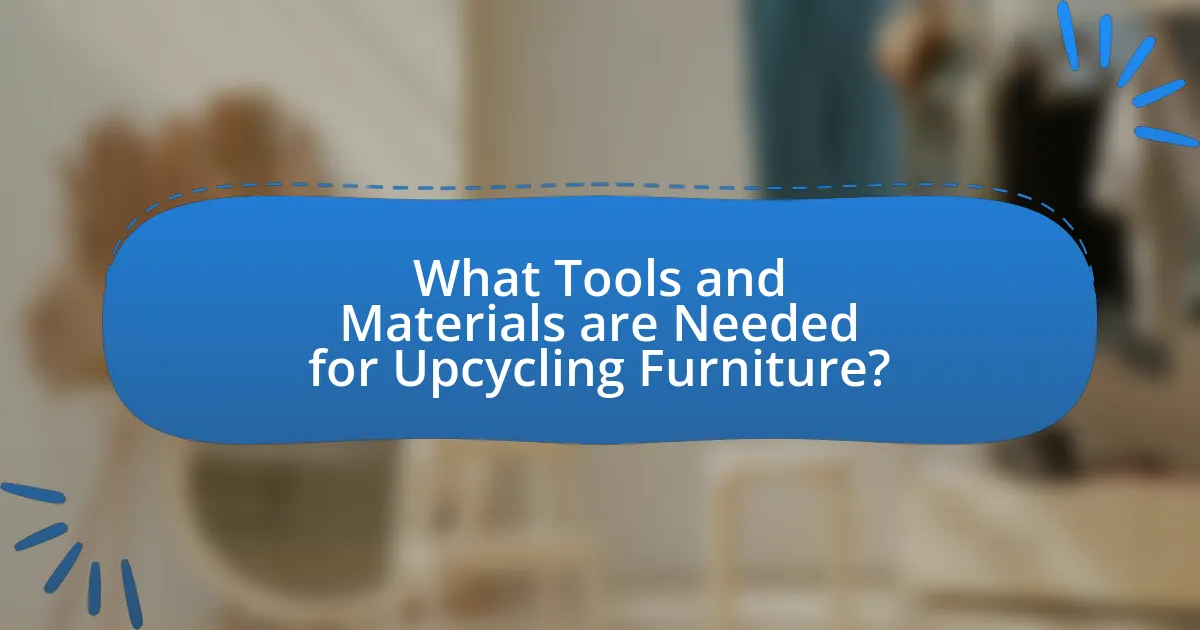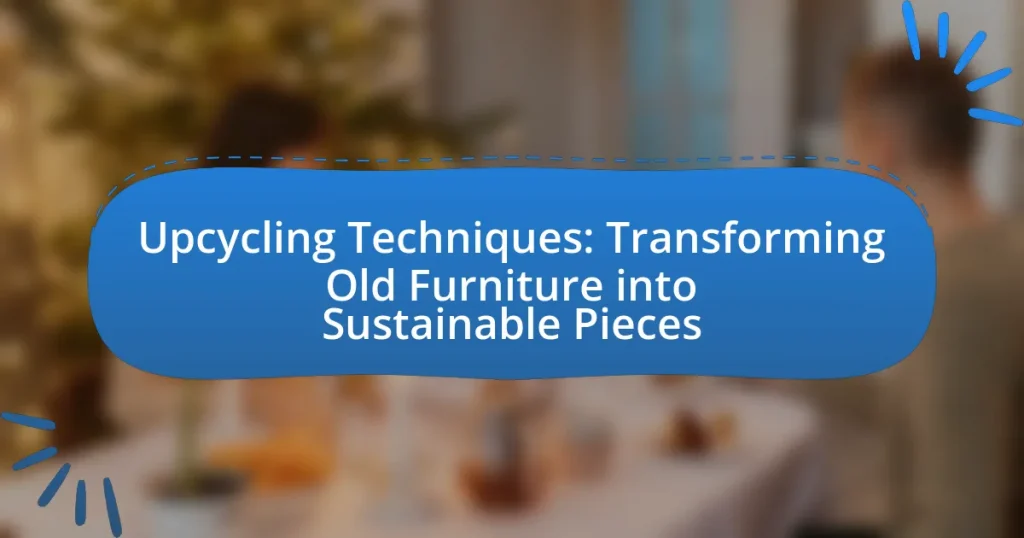Upcycling techniques for furniture involve creatively repurposing old or discarded items to create functional and aesthetically pleasing pieces, contributing to sustainability by reducing waste and extending the life of materials. Key methods include painting, reupholstering, and repurposing, which enhance the value and uniqueness of furniture. The article explores the differences between upcycling and traditional recycling, the materials suitable for upcycling, and the environmental and economic benefits associated with these practices. Additionally, it provides practical tips, essential tools, and resources for individuals looking to embark on their own upcycling projects, emphasizing the importance of quality and creativity in transforming old furniture into sustainable pieces.

What are Upcycling Techniques for Furniture?
Upcycling techniques for furniture involve creatively repurposing old or discarded items to create functional and aesthetically pleasing pieces. Common techniques include painting or staining to refresh surfaces, reupholstering to change fabric and style, and combining multiple items to form new furniture, such as turning an old door into a table. These methods not only reduce waste but also promote sustainability by extending the life of furniture. According to a study by the Ellen MacArthur Foundation, upcycling can significantly decrease landfill waste and resource consumption, making it an effective approach to sustainable living.
How do Upcycling Techniques differ from traditional recycling?
Upcycling techniques differ from traditional recycling in that upcycling creatively repurposes materials into new products without breaking them down, while traditional recycling involves processing materials to create raw materials for new products. Upcycling enhances the value of the original item, often resulting in unique, functional art or furniture, whereas traditional recycling focuses on reducing waste and conserving resources by reprocessing materials. For example, upcycling a wooden pallet into a coffee table adds aesthetic and functional value, while recycling the same pallet would convert it into wood chips or pulp for new products.
What materials can be upcycled in furniture projects?
Wood, metal, fabric, and glass are materials that can be effectively upcycled in furniture projects. Wood can be repurposed from pallets, old furniture, or reclaimed wood, allowing for the creation of new pieces while reducing waste. Metal components, such as pipes or old furniture frames, can be transformed into stylish and functional items. Fabric from old clothing or curtains can be used to upholster furniture, giving it a fresh look. Glass from bottles or old windows can be incorporated into designs, adding unique aesthetic elements. These materials not only contribute to sustainability but also allow for creative expression in furniture design.
Why is upcycling considered a sustainable practice?
Upcycling is considered a sustainable practice because it extends the lifecycle of materials, reducing waste and the demand for new resources. By transforming discarded items into functional or artistic products, upcycling minimizes landfill contributions and conserves energy and raw materials typically required for manufacturing new goods. For instance, a study by the Ellen MacArthur Foundation highlights that upcycling can significantly lower carbon emissions associated with production processes, thereby promoting environmental sustainability.
What are the benefits of Upcycling Old Furniture?
Upcycling old furniture offers several benefits, including environmental sustainability, cost savings, and unique aesthetic appeal. By repurposing existing materials, upcycling reduces waste and minimizes the demand for new resources, contributing to a decrease in landfill usage and carbon emissions. According to the Environmental Protection Agency, furniture accounts for a significant portion of municipal solid waste, highlighting the importance of reusing items to mitigate environmental impact. Additionally, upcycling can save money compared to purchasing new furniture, as it often involves using materials that are already available. Finally, upcycled furniture provides a distinctive look that reflects personal style, as each piece is often one-of-a-kind, enhancing the character of a living space.
How does upcycling contribute to environmental sustainability?
Upcycling contributes to environmental sustainability by reducing waste and conserving resources. By transforming discarded materials into new products, upcycling minimizes the amount of waste sent to landfills, which accounted for approximately 292.4 million tons in the United States in 2018. This process also decreases the demand for new raw materials, thereby conserving natural resources and reducing energy consumption associated with manufacturing. For instance, upcycling furniture not only extends the life of existing items but also lessens the carbon footprint associated with producing new furniture, which can involve significant emissions.
What economic advantages does upcycling offer to individuals?
Upcycling offers individuals significant economic advantages by reducing costs associated with purchasing new items and creating potential income through resale. By transforming old furniture into new, usable pieces, individuals save money on materials and products, as upcycling often utilizes items that would otherwise be discarded. Additionally, a study by the Ellen MacArthur Foundation highlights that upcycling can lead to increased value creation, with upcycled products often selling at a premium compared to their original state. This dual benefit of cost savings and potential profit underscores the economic viability of upcycling for individuals.

What are the Most Popular Upcycling Techniques for Furniture?
The most popular upcycling techniques for furniture include repainting, reupholstering, and repurposing. Repainting allows for a fresh look and can incorporate various techniques such as distressing or stenciling to enhance aesthetics. Reupholstering involves replacing old fabric with new materials, which can significantly change the appearance and comfort of chairs and sofas. Repurposing transforms furniture into new functional items, such as turning an old dresser into a TV stand or using wooden pallets to create outdoor furniture. These techniques not only extend the life of furniture but also contribute to sustainability by reducing waste.
How can painting transform old furniture?
Painting can transform old furniture by enhancing its aesthetic appeal and extending its lifespan. A fresh coat of paint can cover scratches, stains, and outdated finishes, making the furniture look new and inviting. Additionally, using specific paint types, such as chalk paint or spray paint, can create various textures and finishes that align with modern design trends. This process not only revitalizes the furniture but also allows for personalization, enabling individuals to match their decor or express their style. According to a study by the Furniture Industry Research Association, painted furniture can increase perceived value and marketability, demonstrating that painting is an effective upcycling technique for old furniture.
What types of paint are best for upcycling furniture?
Chalk paint and acrylic paint are the best types for upcycling furniture. Chalk paint adheres well to various surfaces without extensive prep work and provides a matte finish that is popular for a vintage look. Acrylic paint, on the other hand, offers durability and a wide range of colors, making it suitable for both indoor and outdoor furniture. Both types are water-based, which makes them easy to clean up and environmentally friendly, aligning with sustainable practices in upcycling.
How can color choices impact the final look of upcycled pieces?
Color choices significantly influence the final look of upcycled pieces by altering their aesthetic appeal and perceived value. For instance, vibrant colors can create a modern and playful appearance, while muted tones often evoke a sense of sophistication and elegance. Research indicates that color psychology plays a crucial role in consumer perception; for example, a study published in the Journal of Environmental Psychology found that colors can affect emotional responses and purchasing decisions. Therefore, selecting the right color not only enhances the visual impact of upcycled furniture but also influences how potential buyers perceive its quality and desirability.
What role does reupholstering play in upcycling?
Reupholstering plays a crucial role in upcycling by extending the life of furniture and reducing waste. This process involves replacing the fabric and padding of old furniture, which not only revitalizes its appearance but also enhances its functionality. According to the Environmental Protection Agency, furniture accounts for a significant portion of landfill waste, and reupholstering helps mitigate this by allowing items to be reused rather than discarded. By transforming outdated or damaged pieces into stylish, usable items, reupholstering contributes to sustainable practices and promotes a circular economy.
What fabrics are suitable for reupholstering old furniture?
Durable fabrics suitable for reupholstering old furniture include cotton, linen, polyester, leather, and microfiber. Cotton is breathable and easy to clean, making it a popular choice for various furniture styles. Linen offers a natural look and is strong, though it can wrinkle easily. Polyester is known for its durability and resistance to fading, while leather provides a classic, luxurious finish that ages well. Microfiber is stain-resistant and soft, ideal for high-traffic areas. These fabrics are chosen based on their ability to withstand wear and tear, ensuring longevity in upcycled furniture projects.
How can reupholstering change the style of a piece?
Reupholstering can significantly change the style of a piece by altering its fabric, color, and overall aesthetic. By selecting new materials that reflect current design trends or personal preferences, the visual impact of the furniture is transformed, making it more contemporary or aligned with a specific decor style. For instance, replacing outdated upholstery with vibrant patterns or textures can modernize a vintage chair, while a neutral fabric can create a more minimalist look. This process not only enhances the piece’s appearance but also extends its lifespan, contributing to sustainable practices in furniture design.

What Tools and Materials are Needed for Upcycling Furniture?
To upcycle furniture, essential tools and materials include sandpaper, paint or wood stain, brushes or rollers, a screwdriver, a hammer, nails or screws, and a measuring tape. Sandpaper is necessary for smoothing surfaces, while paint or wood stain allows for aesthetic transformation. Brushes or rollers are used for applying finishes, and a screwdriver and hammer are crucial for disassembling and reassembling furniture. Nails or screws provide structural integrity, and a measuring tape ensures accurate dimensions during the upcycling process. These tools and materials are fundamental for effectively transforming old furniture into sustainable pieces.
What essential tools should every upcycler have?
Every upcycler should have a set of essential tools that facilitate the transformation of old furniture into sustainable pieces. Key tools include a power drill for assembling and disassembling furniture, a saw for cutting materials to size, sandpaper for smoothing surfaces, and paint or stain for finishing touches. Additionally, a measuring tape ensures accurate dimensions, while a staple gun is useful for reupholstering. These tools are critical as they enable efficient and effective upcycling, allowing individuals to creatively repurpose items while minimizing waste.
How do different tools affect the upcycling process?
Different tools significantly enhance the upcycling process by improving efficiency, precision, and creativity. For instance, power tools like saws and drills allow for quicker disassembly and assembly of furniture, enabling more complex designs and structural integrity. Hand tools, such as sanders and paintbrushes, facilitate detailed finishing touches that elevate the aesthetic appeal of upcycled pieces. Additionally, specialized tools like upholstery kits enable the transformation of furniture fabrics, expanding the range of upcycling possibilities. The use of appropriate tools not only streamlines the process but also ensures higher quality outcomes, as evidenced by the increased popularity of DIY upcycling projects, which often rely on the effective use of tools to achieve professional-looking results.
What safety equipment is necessary during upcycling projects?
Safety equipment necessary during upcycling projects includes safety goggles, gloves, a dust mask, and ear protection. Safety goggles protect the eyes from debris and dust, while gloves safeguard the hands from sharp objects and chemicals. A dust mask is essential to prevent inhalation of harmful particles, especially when sanding or painting. Ear protection is important when using power tools that generate high noise levels. These safety measures are critical to ensure a safe working environment and to minimize the risk of injury during upcycling activities.
What materials are commonly used in upcycling furniture?
Common materials used in upcycling furniture include wood, metal, fabric, and glass. Wood is frequently repurposed from old furniture pieces or pallets, allowing for creative transformations into new items. Metal components, such as frames or hardware, can be refinished or combined with other materials to create unique designs. Fabric, often sourced from discarded textiles or old upholstery, is used for reupholstering or creating new soft furnishings. Glass, whether from old tables or jars, can be incorporated into new furniture designs or decorative elements. These materials are favored for their availability and versatility in creating sustainable furniture solutions.
How can reclaimed wood be utilized in upcycling?
Reclaimed wood can be utilized in upcycling by transforming it into new furniture, decorative items, or building materials. This process not only reduces waste but also preserves the unique character and history of the wood. For example, reclaimed wood can be crafted into tables, chairs, or shelving units, which adds aesthetic value and sustainability to home decor. According to the U.S. Environmental Protection Agency, using reclaimed materials can significantly reduce the environmental impact associated with new wood production, including deforestation and carbon emissions.
What are the benefits of using eco-friendly materials?
Using eco-friendly materials reduces environmental impact and promotes sustainability. These materials often come from renewable resources, minimizing the depletion of natural resources and reducing carbon emissions associated with production. For instance, bamboo, a rapidly renewable resource, can sequester carbon dioxide and produce oxygen at a higher rate than traditional timber. Additionally, eco-friendly materials often involve less harmful chemicals in their production, leading to improved indoor air quality and reduced health risks for consumers. Studies show that using sustainable materials can also enhance the durability and lifecycle of products, ultimately leading to less waste in landfills.
What are some common challenges in Upcycling Furniture?
Common challenges in upcycling furniture include structural integrity issues, material compatibility, and time constraints. Structural integrity problems arise when old furniture is damaged or weakened, making it difficult to ensure safety and durability after upcycling. Material compatibility challenges occur when combining different materials, which may not adhere well or may require specialized techniques to work together effectively. Time constraints often hinder the upcycling process, as transforming furniture can be labor-intensive and may require extensive planning and execution. These challenges can impact the overall success and quality of the upcycled piece.
How can one overcome difficulties in sourcing materials?
To overcome difficulties in sourcing materials, one can establish strong relationships with local suppliers and explore alternative sourcing options. Building connections with local suppliers can provide access to unique materials and foster collaboration, while exploring alternative options such as online marketplaces or community exchanges can expand the range of available resources. For instance, a study by the Ellen MacArthur Foundation highlights that local sourcing not only reduces transportation costs but also supports local economies, making it a viable strategy for sourcing materials effectively.
What are the best practices for ensuring quality in upcycled pieces?
The best practices for ensuring quality in upcycled pieces include thorough material assessment, proper cleaning and preparation, skilled craftsmanship, and quality finishing techniques. Assessing materials ensures that only durable and suitable components are used, which is crucial for the longevity of the final product. Cleaning and preparing materials removes contaminants and enhances adhesion for paints or finishes, thereby improving the overall appearance and durability. Skilled craftsmanship, including precise measurements and techniques, guarantees that the upcycled piece is functional and aesthetically pleasing. Finally, applying quality finishing techniques, such as sanding and sealing, protects the piece and enhances its visual appeal, ensuring that it meets both functional and aesthetic standards. These practices collectively contribute to the creation of high-quality upcycled furniture that is sustainable and appealing.
What are some practical tips for successful Upcycling?
Successful upcycling involves creativity, planning, and resourcefulness. Start by selecting items that are structurally sound and have potential for transformation, such as old furniture or household items. Assess the materials and tools needed for the project, ensuring you have everything on hand to avoid interruptions.
Incorporate techniques like painting, reupholstering, or adding new hardware to enhance the aesthetic appeal. Researching design trends can provide inspiration and help you create pieces that are both functional and stylish.
Additionally, consider the environmental impact; using non-toxic paints and sustainable materials can make your upcycled items more appealing to eco-conscious consumers. According to a study by the Ellen MacArthur Foundation, upcycling can significantly reduce waste and promote a circular economy, reinforcing the value of transforming old items into new treasures.
How can one start their first upcycling project effectively?
To start an upcycling project effectively, one should first select a suitable item that has potential for transformation, such as old furniture. This selection process involves assessing the item’s condition, style, and materials to ensure it can be creatively repurposed. Researching various upcycling techniques, such as painting, reupholstering, or adding new hardware, can provide inspiration and practical methods for the project. Additionally, gathering necessary tools and materials, like paint, brushes, fabric, and screws, is crucial for execution. According to a study by the Ellen MacArthur Foundation, upcycling not only reduces waste but also promotes creativity and sustainability, making it a valuable endeavor.
What resources are available for learning upcycling techniques?
Online platforms such as YouTube, Pinterest, and various DIY blogs provide extensive resources for learning upcycling techniques. YouTube features numerous tutorial videos that demonstrate step-by-step processes for transforming old furniture, while Pinterest offers a wealth of creative ideas and links to detailed guides. Additionally, websites like Instructables and DIY Network provide comprehensive articles and project plans specifically focused on upcycling. These resources are validated by the growing community of DIY enthusiasts who share their projects and experiences, making them reliable for anyone looking to learn upcycling techniques.

